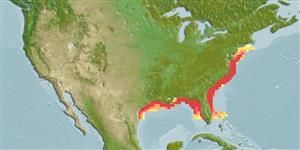Environment: milieu / climate zone / depth range / distribution range
Ecología
marino; salobre demersal; rango de profundidad ? - 98 m (Ref. 89891). Subtropical; 43°N - 26°N, 98°W - 70°W
Western Atlantic: Massachusetts to Texas in the USA, except for southern Florida. Including Gulf of Mexico (Ref. 26938).
Tamaño / Peso / Age
Maturity: Lm ? range ? - ? cm
Max length : 25.0 cm TL macho / no sexado; (Ref. 7251); common length : 16.0 cm TL macho / no sexado; (Ref. 3702)
Espinas dorsales (total): 11; Radios blandos dorsales (total): 24-27; Espinas anales 2; Radios blandos anales: 6 - 7. Colour greyish olive above, silvery white below. Back with 7 to 9 rather conspicuous dark vertical bars. Inside of opercle dark. Lower parts of pelvic fins, anal and caudal fins yellowish. A moderately small fish, body short and robust. Mouth large, strongly oblique, lower jaw projecting. Teeth very small and pointed, set in 1 or 2 rows along edges of jaws. Chin without barbels, but with 4 minute pores. Snout with 5 marginal pores and no rostral pores. Gas bladder simple, carrot-shaped, without anterior appendages. Sagitta (Large earstone) short but very thick (Ref 51721).
Occurs usually over mud and sandy mud bottoms in coastal waters to about 60 m depth, more rarely in estuaries. Feeds mainly on small shrimps.
Life cycle and mating behavior
Madurez | Reproducción | Puesta | Huevos | Fecundidad | Larva
Robins, C.R. and G.C. Ray, 1986. A field guide to Atlantic coast fishes of North America. Houghton Mifflin Company, Boston, U.S.A. 354 p. (Ref. 7251)
IUCN Red List Status (Ref. 130435)
Threat to humans
Harmless
Human uses
Pesquerías: sin interés; carnada: usually
Más información
ReferenciasAcuiculturaPerfil de acuiculturaRazasGenéticaElectrophoresesheritabilidadEnfermedadesProcesamientoNutrientsMass conversion
ColaboradoresImágenesStamps, Coins Misc.SonidosCiguateraVelocidadTipo de nataciónSuperficie branquialOtolitosCerebrosVisión
Herramientas
Special reports
Download XML
Fuentes de Internet
Estimates based on models
Preferred temperature (Ref.
123201): 14.1 - 24.7, mean 23.8 °C (based on 198 cells).
Phylogenetic diversity index (Ref.
82804): PD
50 = 0.5156 [Uniqueness, from 0.5 = low to 2.0 = high].
Bayesian length-weight: a=0.00851 (0.00413 - 0.01752), b=3.08 (2.91 - 3.25), in cm total length, based on LWR estimates for this (Sub)family-body shape (Ref.
93245).
Nivel trófico (Ref.
69278): 3.6 ±0.3 se; based on diet studies.
Generation time: 1.1 ( na - na) years. Estimated as median ln(3)/K based on 1
growth studies.
Resiliencia (Ref.
120179): Alto, población duplicada en un tiempo mínimo inferior a 15 meses (K=0.98).
Fishing Vulnerability (Ref.
59153): Low vulnerability (16 of 100).
Nutrients (Ref.
124155): Calcium = 147 [78, 328] mg/100g; Iron = 1.55 [0.80, 2.88] mg/100g; Protein = 19.6 [18.5, 20.8] %; Omega3 = 0.407 [0.223, 0.693] g/100g; Selenium = 26.9 [13.5, 55.2] μg/100g; VitaminA = 15.6 [5.5, 58.4] μg/100g; Zinc = 0.981 [0.673, 1.458] mg/100g (wet weight);
